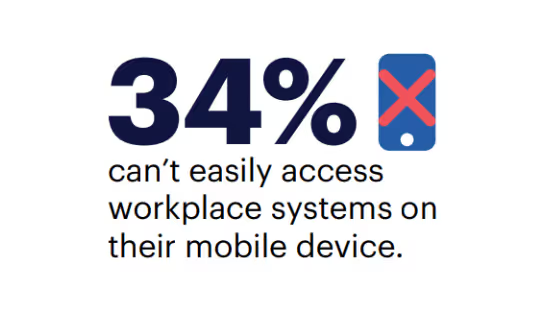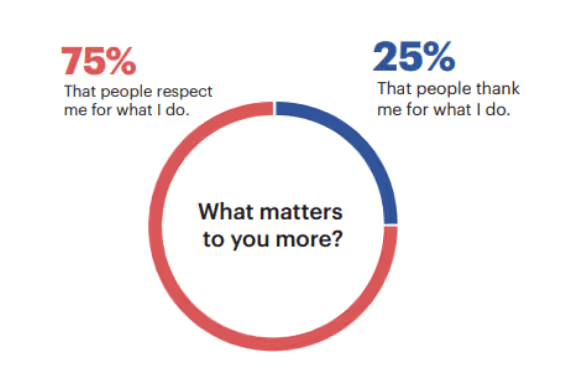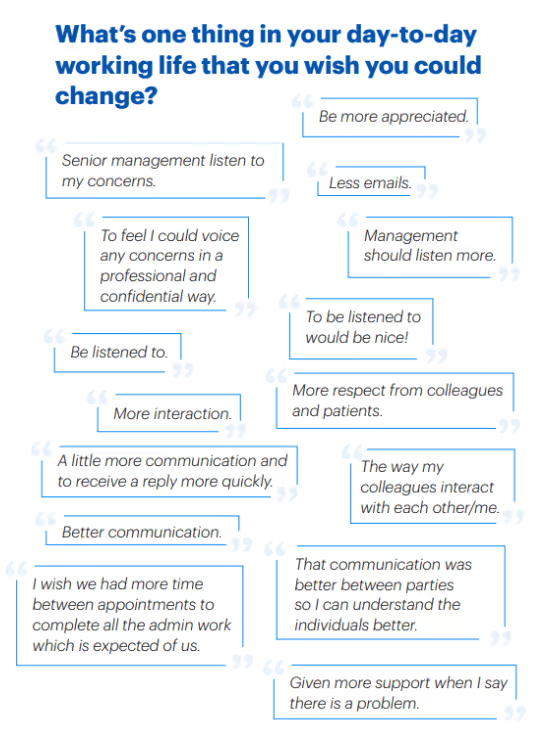Employee engagement is fast becoming one of the most important features of a successful modern business.
It has become a strategic priority for frontline workers in particular who make up 80% of the global workforce yet continue to feel undervalued and are leaving their jobs or the frontline altogether in record numbers.
The truth is, without effective employee engagement, businesses are at risk of damaging their profitability and losing their most valuable asset – their employees. And unfortunately, employee engagement still has a lot of room for improvement.
So we’ve collated the key data from our own UK-based, frontline-focused employee engagement research with some of the latest global 2023 employee engagement statistics to offer you a comprehensive – and up-to-date – guide to engagement in the workplace.
Note: Our research surveyed 1000 respondents over the age of 18 from the United Kingdom in August 2021. At the time of the survey, respondents held frontline roles in both public and private health and social care.
Employee Engagement Statistics
"Global employee vital signs — engagement and wellbeing — remain stable but not great."
Gallup's latest State of the Global Workplace: 2022 Report highlights some key figures we should be aware of as we move closer to 2023. Currently, Gallup states, 21% of employees are engaged at work and 33% of employees are thriving (i.e. engaged) in their overall wellbeing.
Unfortunately, that leaves the majority of the workforce struggling.
With this, it's no surprise that results and performance aren't where they should be. This is not an ideal situation for employers, who need to ensure high levels of employee engagement in order to maintain productivity and profitability, meet employee engagement targets and reduce complexity and overhead for their teams.
But how do we define an engaged workforce? The Harvard Business Review describes an engaged employee as someone who is committed to their employer and identifies with their organization, has job satisfaction, and feels energized while at work.
The impact of employee engagement
Forbes goes on to tell us that professional teams who score in the top 20% in employee engagement realise a 41% reduction in absenteeism. Further highlighting the benefits of improving employee engagement in the workplace, research shows that highly engaged business units are also seen to achieve a 43% difference in turnover.
As actively disengaged employees cost global companies nearly $350 billion a year according to Gallup, not only can high employee engagement improve employee retention, job satisfaction and productivity amongst workers, it can also save you significant money on valuable expenses.
Other statistical benefits of highly engaged businesses include:
- Highly engaged organizations benefit from 10% higher customer ratings and 18% higher sales.
- Highly engaged organizations achieve a 23% difference in profitability.
So, what can businesses do to turn things around and create a more engaged workforce? Well, research shows that better workplace tech could be the place to start.
Workplace Technology Statistics
In our research, almost one-fifth of workers state that they don’t receive relevant communications from their employer organization. A similar number don’t, or no longer, use their intranet, with two-thirds of those not sure how to log on.
With 52% of frontline workers claiming they would leave their job over tech tools, it’s clear to see the impact that the right workplace technology has on a company.
Despite businesses being behind on the uptake of effective comms practices, according to a report by Connected Culture employees who regularly communicate with one another are more productive.
In fact, 71% of employees who said they were more productive feel well-connected to their colleagues. In addition to this, McKinsey reports that well-connected teams see a productivity increase of 20–25%.
With these business and employee benefits of better workplace communication, our research on the use of employee comms is disheartening. It seems that most companies don't know how to choose the right employee communication strategy, or the right employee engagement app to get them the results they need.
Some key workplace technology stats to note:
- Over one third (34%) of respondents say they can’t easily access workplace systems on their mobile.
- Most companies are using an intranet, but nearly 2 in 10 aren’t, and of those two thirds don’t know how to.

Attitudes Towards Work Statistics
Are employees happy at work? Statistics say no.
Gallup finds that 60% of people are emotionally detached (actively disengaged) at work, and 19% are miserable. Employees are increasingly suffering from burnout, especially on the frontline. Whilst 71% of C-suite executives believe their organization takes care of mental health, 70% of frontline workers have either suffered from burnout or felt at risk of burning out.
In one of the largest studies of workplace burnout, Gallup found that the biggest source of unhappiness at work was unfair treatment, followed by an unmanageable workload, unclear communication from managers, lack of manager support and unreasonable time pressure.
With reports like these, it's vital for business leaders to take action and focus on what really matters to their disengaged workers. To address this, statistics show that improving employee respect, and prioritizing employees' physical and mental wellbeing within your company and workforce can have some key benefits.
In our employee engagement surveys, the majority of frontline workers (75%) would rather they were shown respect than be thanked. This number is stronger amongst ethnic minority groups.
Higher levels of respect in the workplace can also be linked to better work performance, with Gallup data stating that 95% of people who are thriving at work report being treated with respect all day and 87% report smiling and laughing a lot.
Further notable distinctions between highly engaged and disengaged employees include:
- When asked about stress, 49% of not engaged employees had experienced stress the previous day, compared to 30% of engaged employees.
- 24% of not engaged employees reported feeling anger the previous day, compared to 11% of engaged employees.
- 16% of not engaged employees reported health problems, compared to only 8% of engaged employees.
With this in mind, employers can prioritize creating a culture of diversity, inclusion and respect that values its employees' work and prioritizes their professional and personal development as well as mental health. Leaders must identify the stressors which are causing employees to feel burnt out and preventing them from being happy, and take appropriate actions to improve their everyday lives. This will create a safe environment for employees where they can trust management to care for their wellbeing.

Our research also shows that nearly 4 in 10 (37%) frontline workers don’t feel as valued as their desk-based colleagues. To engage actively disengaged workers, particularly in the frontline sector, it's vital that employees feel valued regardless of their role functions.
This is supported by research finding that 51% of frontline workers believe they are seen as less important than their HQ counterparts.
A highly engaged workforce feels heard and seen in the working environment, so if your business units are working without praise or direct acknowledgment, you may see higher employee churn rates as well as a knock to your company reputation and even your bottom line.
Employee Care and Support Statistics
When it comes to engaging employees through professional care and mental support, our research states that nearly 4 in 10 workers don’t feel that their feedback will be acted on and a quarter don’t believe that their employer cares about their mental well-being.
Further to this, research shows that 87% of workers believe their employer should do more to listen to the needs of their workforce. This shines a light on how employee engagement needs to be a two-way street, and feedback needs to be listened to and actioned to encourage employees to stay motivated.
This is why a standard of care and support is essential to employee engagement – it shows that you as an employer are committed to their well-being and development. It also helps to build trust between employees and management, which is essential for a healthy workplace culture.
Key employee care and support stats include:
- Over a third (35%) of frontline healthcare workers feel that their organization will not act on their feedback.
- A quarter of frontline healthcare workers feel that their organization doesn’t care about their mental health.
- 22% of minority ethnic frontline feel their organization doesn’t treat everyone equally, regardless of ethnicity.

Working From Home Statistics
According to Gallup Data the popularity of hybrid work is continuing to increase in 2022, from 42% in February to 49% in June. Further to this, 54% of workers in one study claimed they would leave their current job positions to pursue positions in companies that allow working from home.
With this in mind, remote employee engagement strategies are especially vital. Even when employees are working from home, companies need engaged workers. Particularly as stats show that a thriving company culture leads to increased job satisfaction - and performance - in remote employees.
In fact, McKinsey’s remote work report states that remote employees who feel more included in workplace communication are almost 5 times more likely to report increased productivity.
Our Frontline Health Survey Results
So, now we know the stats, but what are employees actually saying about their employee engagement levels? It’s important to gather direct feedback and communicate with employees regularly to understand their needs, concerns and motivations.
Our survey revealed the following employee engagement questionnaire results:
What’s one thing in your day-to-day working life that you wish you could change?
Some responses included:
- To have senior leaders listen to my concerns
- To feel I can voice concerns in a professional and confidential way
- To be listened to, respected and appreciated.
- To receive better communication, interaction and support.
With the 2022 State of the Global Workplace Report also stating that ‘Helping the world’s workers thrive starts with listening to them’, it’s vital to take into account employee feedback and tailor your engagement strategies accordingly. This can range from providing better tools dedicated to two-way communication and feedback, to implementing new policies that promote better work-life balance.
By taking the time to listen and understand what your employees need, you can enhance their experience at work, boost their engagement, improve morale and ultimately drive business success.

If you could say one thing to senior management anonymously what would it be?
Some responses included:
- Please answer my emails and questions. I am trying to do my best at work and would appreciate feeling listened to.
- Listen to us. Listen to your staff.
- Communication, please!
- I don't know, I feel like I don't have much contact with them.
With this in mind, it’s important for senior management to ensure they are accessible and approachable to all employees. This can range from setting up regular check-ins or 1:1s, to implementing a confidential chat/feedback system where employees feel comfortable voicing their concerns without fear of retribution.
By creating open lines of communication built into the right employee tech, your team will feel heard and valued, leading to both improved engagement and productivity.
So what does this mean for business leaders?
The key to success with employee engagement is identifying exactly what fits into your staff’s working environment and how it can streamline or improve their employee experience. That means ensuring your employee engagement strategies stretch beyond the office and into your frontline and remote employees too.
For example, frontline employees will require different features from their employee engagement tech than desk-based office workers. This unfortunately puts frontline workers in a difficult position as most employee apps are designed for desk-based work.
Successful organizations focus on aligning their employee engagement and improving employee morale on all fronts, whatever the industry. With the rise in home working and the majority of the global workforce working on the frontline, this has become more important than ever to focus on. Finally, it's important to approach engagement as something that is earned as a result of consistently providing value to your employees, rather than an isolated tool or strategy.
Here are 4 actions that leaders can take now to improve employee engagement:
1. Ensure employees and managers are engaging in empathetic, transparent and regular two-way conversations
2. Implement a consistent feedback loop between leadership and employees that is being used to influence output and improve the employee experience
3. Promote a work-life balance for employees and prioritize employees' mental health and well being
4. Use the right technology designed for your workforce to create an accessible space for ongoing virtual collaboration and communication.
If you are managing a frontline workforce, the best way to improve employee communication and engagement is by using an industry-leading frontline engagement app like Blink.
Why Blink?
As recent data shows, the majority of frontline workers feel burned out, underappreciated — and ready to leave their current jobs.
The world needs technology that puts frontline workers first, by fitting into their lives and making them better and easier and creating an environment which invites organic engagement. At Blink, our platform is dedicated to this mission by providing a digital space to connect your employees with each other and with management.
Our industry-leading employee engagement solution opens up efficient lines of two-way communication, streamlines workflows with user-friendly digital processes and drives employee productivity, satisfaction and retention.
Blink can also be used to deliver reliable metrics and provide better visibility around employee engagement stats through its Frontline Intelligence feature. It offers real-time connection with the frontline and key insights into how they are interacting with each other, leadership and company content.

